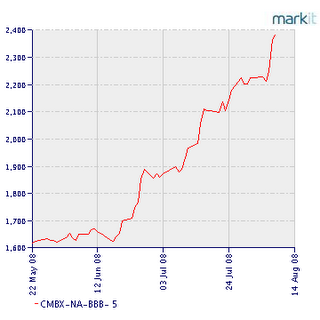Anthracite recently established a third credit facility with its parent Blackrock. The support from Blackrock is encouraging, and AHR appears to be using that facility to meet its margin calls. AHR drew down $52.5MM when market conditions worsened around the time of the Bear Stearns failure, then paid it back down to zero in April as the market improved. AHR drew on this facility again on July 28th in the amount of $30MM.
It’s worth noting that the Markit Group’s analagous BBB CMBX index shot through the roof (up is down) in June and July, at the same time that AHR drew on the Blackrock facility, and a graphical illustration of that index helps put Chris Milner’s market commentary in context:
“After a period of relative stability in April and May, the markets suffered another major setback in June and July as continuing economic weakness combined with the challenges faced by the residential mortgage market put significant pressure on financial stocks and credit spreads.”

Investors in Anthracite need to continually reconsider the the damage that is being inflicted by this index. The reason is that this damage is divided into two categories: permanent capital losses, which until now have been largely confined to the subprime mortgage sector and related structured products; and temporary mark-to-market losses, which are hitting all credit products, including the securities in which Anthracite invests.
REITwrecks readers say that six times fast know that these mark-to-market losses on CMBS have had little or nothing to do with the underlying performance of the collateral, which with very few exceptions continue to exhibit strong financial performance.
However, more and more observers are questioning whether these paper losses will not soon become permanent capital losses. Obviously, with Anthracite’s portfolio concentrated on the lowest rung in the CMBS food chain (BB rated “Controlling Class” CMBS), pressure on the stock has been consistent.
AHR has a fairly well diversified BB CMBS portfolio by geography, but the portfolio summary in the earnings release shows that AHR could be in some trouble with respect to the more recent vintages (2005, 2006 and 2007). These three years comprise almost 75% of the portfolio. Those three vintages also comprise about 49% of the outstanding CMBS market, so it’s not surprising that AHR would have a concentration there. In those three vintages, AHR currently estimates that its portfolio will experience collateral losses of almost 50%.
As everyone knows, these particular years were also the height of the bubble, and Fitch recently reported that it believes defaults on CMBS issued in those years could quadruple from their current levels, under a worst-case scenario for the U.S. economy.
According to the Fitch estimates, borrowers would default on an average of 17.2% of securitized commercial mortgages over 10 years if the US economy dips into a recession with 0.2 per cent contraction in growth (compared with current default rates of 4 per cent), which is a rise of 330 per cent. Fitch’s London office produced similar dour commentary on the European CMBS market a few days earlier.
Such a scenario corresponds “to the negative predictions currently offered by commercial real estate experts”, analysts at Fitch wrote. This would happen if the economy suffered a similar downturn to 1991, and assumes that the value of properties covered by the deals falls by 25 per cent, and cash flow from rents by 15 per cent.
Under a more mild recession, which Fitch thinks is more likely (0.8 per cent economic growth), the default rate would still rise to 13.7%, roughly double the norm.
“Controlling” Class CMBS: controlling what?
AHR says it likes the controlling class CMBS because it is given control over the collateral in order to effect workouts. But what if there is nothing left to work out? Fitch says the more severe scenario would cause non-investment grade bonds – B and BB rated CMBS – to suffer loss rates of 100% and 95.9%, respectively. Meanwhile, only 30.6% of the lowest-rated investment grade bonds – BBB rated – would experience losses, while loss severities would rise to 37.9% from an historical average of 33.5% (but still a far cry from being completely wiped out). 
Clearly, the report suggests that recently issued CMBS were the subject of inflated underlying property values and weaker underwriting standards experienced at the height of the boom in 2006 and 2007. The report’s survey covered all Fitch-rated bonds issued during those two years, which were comprised of 74 deals worth $217.3billion. That was about 60% of all CMBS issued during the period.
Is AHR misunderestimating?
Most reasonable people agree that conditions are worsening. Not surprisingly, the Company also reported that it increased the loss assumptions on its controlling class (across all vintages) CMBS from 1.31% of outstanding collateral at December 31, 2007 to 1.44% at March 31, 2008.
However, the Fitch report suggests that losses in the controlling class losses could be much more severe. Indeed, the report notes that under the 1991 scenario, 3.6 per cent of all 2006 and 2007 bonds (not just BB) will suffer losses. Given that 75% of AHR’s outstanding BB CMBS collateral consists of deeply subordinated 2005, 2006 and 2007 bonds, AHR’s loss estimates could be light.
Nevertheless, even this pessimistic Fitch scenario flies in the face of the losses implied by the CMBX index. That index continues to suggest that losses on some CMBS will exceed the worst levels experienced in the 1990s.
Indeed, Bloomberg reported on Friday that “yields on commercial real estate securities relative to benchmark rates rose to the highest since March on concern that retailers won’t be able to repay debt as consumers cut spending. Spreads on AAA rated commercial mortgage-backed bonds widened 10 bps during the week… to 250.5 bps more than 10-year swap rates… Demand for commercial real estate securities is waning as retailers are forced into bankruptcy during the economic slowdown.”
Obviously, the question on everybody’s mind is how much worse will the economy get and how long will it last? Amidst the uncertainty however, one thing is clear: as reality unfolds, whatever it may be, AHR’s “controlling class” CMBS will be among the very first to receive it. Unfortunately, being a bellwether (bell-weth-er, n. 1. a castrated ram ) in this particular market is not an enviable place to be.

Disclosure: None at the time of this writing.








 ShareThis
ShareThis



